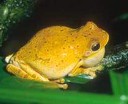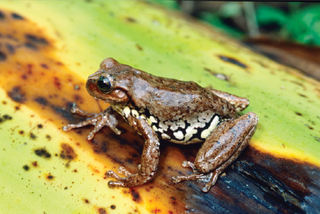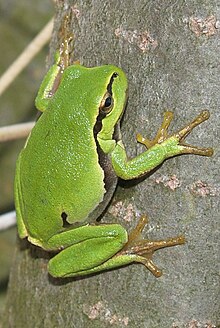
Hylidae is a wide-ranging family of frogs commonly referred to as "tree frogs and their allies". However, the hylids include a diversity of frog species, many of which do not live in trees, but are terrestrial or semiaquatic.

The Mexican burrowing tree frog (Smilisca), also known as the cross-banded tree frog, is a genus of frogs in the family Hylidae found in Mexico, southern Texas and Arizona, Central America, and northwestern South America. In a recent revision of the Hylidae, the two species of the previous genus Pternohyla were included in this genus. Its name is from the Ancient Greek smiliskos, referring to the pointed frontoparietal processes.

Spikethumb frogs are a genus (Plectrohyla) of frogs in the family Hylidae found in Central America from southern Mexico through Guatemala and northern El Salvador to central and northern Honduras. A major revision of the Hylidae moved an additional 21 species to this genus from the genus Hyla. The additional species moved to Plectrohyla were identified as the Hyla bistincta group, also called the Plectrohyla bistincta group; a separate group from the initial Plectrohyla guatemalensis group. This phylogenetic classification was later revised by moving the Plectrohyla bistincta group from the genus Plectrohyla into a new genus called Sarcohyla. Meanwhile, the guatemalensis group remained in Plectrohyla. They are called spikethumb because of the spike on their thumbs, which is called a prepollex. The genus name comes from the Greek word plēktron ("spur") and hyla.

Charadrahyla is a genus of frogs in the family Hylidae. It is endemic to tropical southern Mexico. The generic name was derived from Greek charadra ("ravine") and Hyla, in reference to the habits of these frogs. Accordingly, common name ravine treefrogs has been coined for the genus.
Megastomatohyla is a genus of frogs in the family Hylidae. They are endemic to the cloud forests of central Veracruz and Oaxaca, Mexico. All are rare species with restricted distributions. The generic name is derived from Greek mega (="large") and stem of the genitive stomatos (="mouth"), referring to the enlarged oral disc of the tadpoles, juxtaposed with Hyla, the genus in which the four Megastomatohyla species were previously placed. Common name large-mouthed treefrogs has been coined for this genus.

Tlalocohyla is a genus of frogs in the family Hylidae, also known as rain treefrogs or Middle American yellow-bellied treefrogs. They occur in Middle America between Mexico and Costa Rica. This genus was created in 2005 following a major revision of the Hylidae. The five species in this genus were previously placed in the genus Hyla.

Isthmohyla is a genus of frogs in the family Hylidae. This genus was erected in 2005 following a major revision of the Hylidae. The 15 species in this genus were previously placed in the genus Hyla. They are endemic to Central America in Honduras, Costa Rica, and Panama.

Ecnomiohyla, commonly known as fringe-limbed treefrogs or marvelous frogs, is a genus of frogs in the family Hylidae. This genus was erected in 2005 following a major revision of Hylidae. The ten original species in this genus were previously placed in the genus Hyla. The generic name Ecnomiohyla comes from Greek ecnomios and Hylas, the companion of Hercules.

Bokermannohyla is a genus of frogs in the family Hylidae. It was erected in 2005 following a major revision of the Hylidae. Twenty-three species previously placed in the genus Hyla were moved to this genus named in honor of Werner Carlos Augusto Bokermann, Brazilian herpetologist. The genus is endemic to southern Brazil.
Bromeliohyla, sometimes known as the bromeliad treefrogs, is a genus of frogs in the family Hylidae. This genus was erected in 2022 following a major revision of the Hylidae. The original two species in this genus were previously placed in the genus Hyla. They are found in tropical southern Mexico, Belize, Guatemala, and northern Honduras.

Dendropsophus is a genus of frogs in the family Hylidae. They are distributed in Central and South America, from southern Mexico to northern Argentina and Uruguay. They are sometimes known under the common name Fitzinger neotropical treefrogs or yellow treefrogs
The cloud forest tree frog is a species of frog in the family Hylidae endemic to Mexico. Its natural habitats are subtropical or tropical moist montane forests and rivers. It is threatened by habitat loss.
Jonathan Atwood Campbell is an American herpetologist. He is currently professor of biology at University of Texas at Arlington. He was a distinguished professor and chair of the Department of Biology, University of Texas at Arlington, Arlington, Texas.

Atlantihyla is a genus of frogs in the family Hylidae. It is endemic to Central America, specifically to Honduras and Guatemala. The generic name refers to its distribution on the Atlantic side of the isthmus. The members of the genus are known as stream frogs.

Sarcohyla is a genus of frogs in the family Hylidae. It is endemic to Mexico and is found in the montane parts of the country between Durango in the north and Guerrero in the south. These frogs typically occur in pristine habitats along streams in pine-oak woodland at elevations between 1,500 and 3,100 m above sea level. The generic name is derived from the Greek sarkodes meaning "fleshy" in combination with Hylas and refers to the thick, glandular skin characteristic of most of the species in the genus.

Rheohyla is a genus of frogs in the family Hylidae. As currently recognized, it is monotypic, containing only Rheohyla miotympanum, also known as the small-eared hyla or small-eared treefrog. However, the nominal species likely is a complex of more than one species. It is endemic to eastern and central Mexico. The generic name refers to streams, the breeding habitat of this frog. The specific name is derived from Greek meion, a diminutive prefix, together with Greek tympanon (='drum') and refers to the small tympanum.
Quilticohyla is a genus of frogs in the family Hylidae. They are native to southern Mexico and eastern Guatemala. All species in this genus are endangered or critically endangered.













